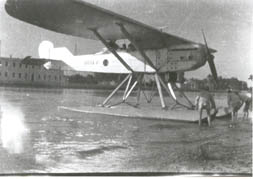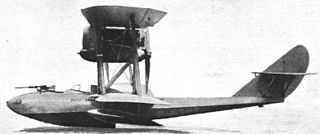
The CANT Z.1007 Alcione (Kingfisher) was an Italian three-engined medium bomber, with wooden structure. Designed by Filippo Zappata, who also designed the CANT Z.506 it had "excellent flying characteristics and good stability" and was regarded by some as "the best Italian bomber of World War II" although its wooden structure was easily damaged by the climate, as experienced in North Africa and in Russia. It was used by the Italian Regia Aeronautica, Italian Co-Belligerent Air Force, Aeronautica Nazionale Repubblicana and Luftwaffe during World War II.

The Fiat CR.20 was an Italian biplane fighter used during the 1920s and 1930s. Designed by Celestino Rosatelli, it represented an intermediate step from the early biplane CR.1 and the later, successful series CR.30, CR.32 and CR.42.

The SIAI S.8 was an Italian 1910s two-seat reconnaissance flying boat.

The Breda A.7 was a reconnaissance aircraft developed in Italy for use by the Regia Aeronautica in 1929. It was a braced parasol monoplane of conventional configuration with tailskid undercarriage. The pilot and observer sat in tandem, open cockpits. A single prototype of a long-range example, originally designated A.7 Raid and later A.16 was also constructed, but the air force showed no interest in it.

The Breda A.9 was a biplane trainer produced in Italy in 1928 for the Regia Aeronautica. Conventional in design, it featured a single-bay, unstaggered wing cellule and fixed tailskid undercarriage. The student and instructor sat in tandem, open cockpits. A slightly smaller version, designated A.9-bis was developed for use in Italy's aeroclubs.

The Caproni Ca.135 was an Italian medium bomber designed in Bergamo in Italy by Cesare Pallavicino. It flew for the first time in 1935, and entered service with the Peruvian Air Force in 1937, and with the Regia Aeronautica in January 1938.

The Caproni Ca.165 was an Italian biplane fighter developed just before World War II, but produced only as a prototype, as the competing Fiat CR.42 Falco was selected for series production.

The Savoia-Marchetti SM.78 was an Italian bomber/reconnaissance biplane flying boat of the early 1930s.

The Savoia-Marchetti SM.62 was an Italian single-engine maritime patrol flying boat produced from 1926. It served with the Regia Aeronautica and with a number of foreign users, and was produced in Spain and the Soviet Union. Some of the Spanish aircraft were still in service during the Spanish Civil War.

The Breda Ba.201 was an Italian dive bomber designed during World War II, that never entered production.
The Piaggio P.32 was an Italian medium bomber of the late 1930s, produced by Piaggio, and designed by Giovanni Pegna. It was a modern design for its time, but was a failure due to lack of powerplants commensurate with its high wing loading.

The Savoia-Marchetti S.59 was a 1920s Italian reconnaissance/bomber flying boat designed and built by Savoia-Marchetti for the Regia Aeronautica.

The Savoia-Marchetti S.57 was an Italian single-engine biplane flying boat intended for aerial reconnaissance, built by Savoia-Marchetti for Regia Aeronautica after World War I.

The Macchi M.24 was a flying boat designed by Alessandro Tonini and produced by Macchi in Italy during the 1920s. Originally intended as a bomber, it was eventually produced for civilian use as well.

The SIAI S.52 was an Italian fighter prototype of 1924.

The Caproni Ca.355 Tuffo was a low-wing single-engine dive bomber, designed and built by the Italian Caproni company in 1941, which never proceeded beyond a single prototype. Derived from Ca.335 Mistral, the Ca.355 was proposed to equip the Regia Aeronautica, but it was found to offer little advantage over the German Junkers Ju 87 "Stuka" and the project was abandoned.

The SIAI S.58 or Savoia-Marchetti S.M.58 was an Italian flying boat fighter prototype of the 1920s designed and manufactured by SIAI.

The Tebaldi-Zari was an Italian fighter prototype of 1919. The Breda company later acquired the rights to it.

The Caproni Ca.134 was a biplane reconnaissance aircraft built by the Italian company Caproni in the 1930s.
The Caproni Ca.146 was a high-wing reconnaissance aircraft built by Caproni in the mid-1930s.


















